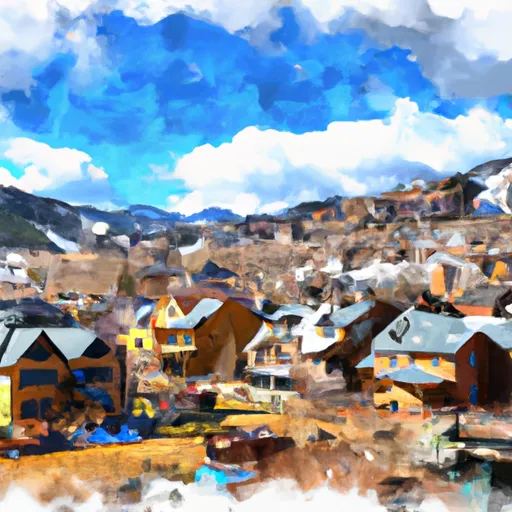-
 Snoflo Premium
Snoflo Premium
Get unlimited access to all our content
With no Ad interruptions! - Start Your Free Trial Login with existing account
Snowmass-Village
Eden Index
Climate
7.0
•
Recreation
7.3
•
Community
•
Safeguard
5.4/10

Snowmass Village is a picturesque mountain town nestled in the Rocky Mountains of Colorado, located just 9 miles from Aspen. This charming village boasts a breathtaking landscape, with an elevation of 8,209 feet and an average annual temperature of 45°F. Snowmass Village experiences a cool alpine climate with four distinct seasons. Winters are typically cold and snowy, making it a haven for winter sports enthusiasts. The area receives an average of 300 inches of snowfall annually, creating excellent conditions for skiing, snowboarding, and snowshoeing.
In terms of hydrology constituents, Snowmass Village is surrounded by pristine rivers and streams. The Roaring Fork River flows nearby, offering opportunities for fishing and kayaking. Additionally, the Snowmass Creek runs through the village, providing a serene setting for outdoor activities.
Outdoor recreation opportunities in Snowmass Village are abundant. The area is renowned for its world-class skiing and snowboarding, with four mountains to choose from. In the summer, visitors can enjoy hiking, mountain biking, and horseback riding on the extensive trail system. Snowmass Village also offers golf courses, tennis courts, and a vibrant cultural scene with music festivals and art exhibits. With its stunning natural surroundings and diverse recreational opportunities, Snowmass Village is a year-round destination for outdoor enthusiasts.
What is the Eden Index?
The Snoflo Eden Index serves as a comprehensive rating system for regions, evaluating their desirability through a holistic assessment of climate health, outdoor recreation opportunities, and natural disaster risk, acknowledging the profound impact of these factors on livability and well-being.
Climate Health Indicator (CHI): 7.0
Snowmass-Village receives approximately
577mm of rain per year,
with humidity levels near 72%
and air temperatures averaging around
5°C.
Snowmass-Village has a plant hardyness factor of
5, meaning
plants and agriculture in this region thrive during a short period during spring and early summer. Most
plants will die off during the colder winter months.
By considering the ideal temperature range, reliable water supplies, clean air, and stable seasonal rain or snowpacks, the Climate Health Indicator (CHI) underscores the significance of a healthy climate as the foundation for quality living.
A healthy climate is paramount for ensuring a high quality of life and livability in a region, fostering both physical well-being and environmental harmony. This can be characterized by ideal temperatures, reliable access to water supplies, clean air, and consistent seasonal rain or snowpacks.
Weather Forecast
Streamflow Conditions
Colorado Headwaters
Area Rivers
Colorado Headwaters
Snowpack Depths
Colorado Headwaters
Reservoir Storage Capacity
Colorado Headwaters
Groundwater Levels
Recreational Opportunity Index (ROI): 7.3
The Recreational Opportunity Index (ROI) recognizes the value of outdoor recreational options, such as parks, hiking trails, camping sites, and fishing spots, while acknowledging that climate plays a pivotal role in ensuring the comfort and consistency of these experiences.
Access to outdoor recreational opportunities, encompassing activities such as parks, hiking, camping, and fishing, is crucial for overall well-being, and the climate plays a pivotal role in enabling and enhancing these experiences, ensuring that individuals can engage in nature-based activities comfortably and consistently.
Camping Areas
| Campground | Campsites | Reservations | Toilets | Showers | Elevation |
|---|---|---|---|---|---|
| Almont | 10 | 7,990 ft | |||
| Gothic | 4 | 9,657 ft | |||
| Rosy Lane | 20 | 8,460 ft | |||
| One Mile | 25 | 8,411 ft | |||
| Cement Creek | 13 | 8,967 ft | |||
| Difficult | 47 | 8,139 ft | |||
| North Bank | 17 | 8,433 ft | |||
| Lake Irwin | 32 | 10,400 ft | |||
| Spring Creek | 12 | 8,544 ft | |||
| Taylor Canyon | 7 | 8,373 ft |
Nearby Ski Areas
Catastrophe Safeguard Index (CSI):
The Catastrophe Safeguard Index (CSI) recognizes that natural disaster risk, encompassing floods, fires, hurricanes, and tornadoes, can drastically affect safety and the overall appeal of an area.
The level of natural disaster risk in a region significantly affects safety and the overall livability, with climate change amplifying these risks by potentially increasing the frequency and intensity of events like floods, fires, hurricanes, and tornadoes, thereby posing substantial challenges to community resilience and well-being.
Community Resilience Indicator (CRI):
The Community Resilience Indicator (CRI) recognizes that education, healthcare, and socioeconomics are crucial to the well-being of a region. The CRI acknowledges the profound impact of these elements on residents' overall quality of life. By evaluating educational resources, healthcare accessibility, and economic inclusivity, the index captures the essential aspects that contribute to a thriving community, fostering resident satisfaction, equity, and social cohesion.

